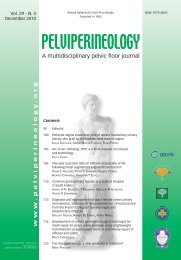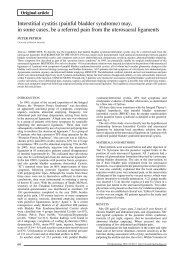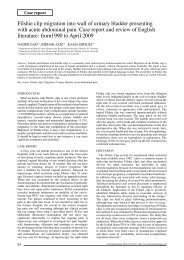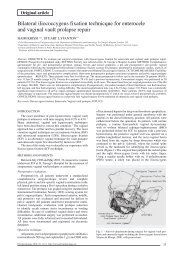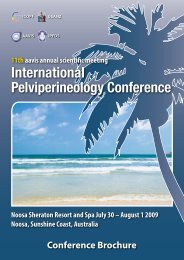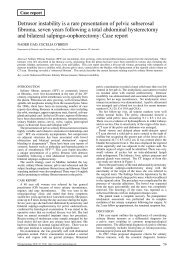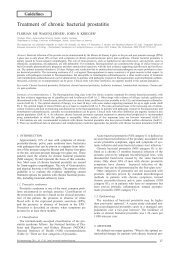This Issue Complete PDF - Pelviperineology
This Issue Complete PDF - Pelviperineology
This Issue Complete PDF - Pelviperineology
Create successful ePaper yourself
Turn your PDF publications into a flip-book with our unique Google optimized e-Paper software.
Pelvic Floor Digest<br />
posterior vaginal or perineal procedures (PR) at each surgeon’s discretion. The preoperative and 1 year postoperative Colorectal-anal Distress<br />
Inventory (CRADI) scores were compared within and between groups using Wilcoxon signed-rank and rank-sum tests, respectively. The sacrocolpopexy<br />
+ PR group (n = 87) had more baseline obstructive colorectal symptoms than the sacrocolpopexy alone group (n = 211). CRADI<br />
total, obstructive, and pain/irritation scores significantly improved in both groups.<br />
Stapled haemorrhoidopexy versus Ferguson haemorrhoidectomy: a prospective study with 2-year postoperative follow-up. Sabanci U,<br />
Ogun I, Candemir G. J Int Med Res. 2007;35:917. Patients with grade III or IV haemorrhoids underwent stapled haemorrhoidopexy (50) or<br />
Ferguson haemorrhoidectomy (50) between 2000 and 2003. Six patients (12.0%) receiving stapled haemorrhoidopexy experienced complications<br />
(bleeding, haematoma, anal fissure) and recurrence in 2.0%. Of those undergoing Ferguson haemorrhoidectomy urinary retention was<br />
seen in three patients (6.0%) We conclude that Ferguson haemorrhoidectomy was safer than stapled haemorrhoidopexy for bleeding complications,<br />
but stapled haemorrhoidopexy was superior to the Ferguson technique in terms of postoperative pain, duration of hospital stay and time<br />
to return to normal activities.<br />
Proctalgia in a patient with staples retained in the puborectalis muscle after STARR operation. De Nardi P, Bottini C, Faticanti Scucchi<br />
L et al. Tech Coloproctol. 2007 Nov 30; epub. Stapled transanal rectal resection is a surgical technique for the treatment of intussusception<br />
and rectocele causing obstructed defecation. The case of a patient complaining of persistent pain, tenesmus and fecal urgency after STARR is<br />
described. The patient also had an external rectal prolapse requiring an Altemeier rectosigmoid resection; during the operation several staples<br />
were removed that had stuck to the puborectalis muscle with some degree of muscle inflammation at histology.<br />
Total rectal lumen obliteration after stapled haemorrhoidopexy: a cautionary tale. Brown S, Baraza W, Shorthouse A. Tech Coloproctol.<br />
2007 Nov 30; epub. The obliteration of the rectal lumen during stapled haemorrhoidopexy in a patient with marked mucosal prolapse was<br />
recognised immediately and continuity was restored by performing a limited Delorme’s procedure.<br />
Transanal haemorrhoidal dearterialisation: nonexcisonal surgery for the treatment of haemorrhoidal disease. Dal Monte PP, Tagariello<br />
C, Giordano P et al. Tech Coloproctol. 2007 Dec 3; epub. Transanal haemorrhoidal dearterialisation (THD) is a nonexcisional surgical technique<br />
for the treatment of piles, consisting in the ligation of the distal branches of the superior rectal artery, resulting in a reduction of blood<br />
flow and decongestion of the haemorrhoidal plexus. From 2000 to 2006 THD was performed in 330 patients (180 men; mean age, 52.4 years),<br />
including 138 second, 162 third and 30 fourth-degree haemorrhoids. There were 23 postoperative complications (bleeding, thrombose, rectal<br />
haematoma, anal fissure, dysuria, haematuria, needle rupture). The mean postoperative pain score was 1.32 on a VAS. 219 patients were followed<br />
for a mean of 46 months (range, 22-79). The operation completely resolved the symptoms in 92.5% of the patients with bleeding and<br />
in 92% with prolapse.<br />
Modified Longo’s stapled hemorrhoidopexy with additional traction sutures for the treatment of residual prolapsed piles. Chen CW,<br />
Kang JC, Wu CC et al. Int J Colorectal Dis. 2007 Nov 20; epub. Residual prolapsed piles is a problem after the stapled hemorrhoidopexy,<br />
especially in large third- or fourth-degree hemorrhoids. We have developed a method using additional traction sutures, and this contributed<br />
to reduce the residual internal hemorrhoids, but a randomized trial and long-term follow-up are needed to determine possible surgical and<br />
functional outcome.<br />
5 – RETENTIONS<br />
Sacral neuromodulation for urinary retention after pelvic plexus injury. Garg T, Machi G, Guralnick ML, O’Connor RC. Urology.<br />
2007;70:811. Injury to the pelvic plexus with resultant urinary retention is a known complication of colectomy. A case of urinary retention<br />
after colectomy successfully treated with the insertion of a pelvic neuromodulator is described.<br />
Mortality in men admitted to hospital with acute urinary retention: database analysis. Armitage JN, Sibanda N, Cathcart PJ. BMJ.<br />
2007;335:1199. Mortality in men admitted to hospital with acute urinary retention is high and increases strongly with age and comorbidity.In<br />
100 067 men with spontaneous acute urinary retention, the one year mortality was 4.1% in men aged 45-54 and 32.8% in those aged 85 and<br />
over. In 75 979 men with precipitated acute urinary retention, mortality was 9.5% and 45.4%, respectively. Patients might benefit from multidisciplinary<br />
care to identify and treat comorbid conditions.<br />
A novel surgical approach to slow-transit constipation: report of two cases. Pinedo G, Leon F, Molina ME, Dis Colon Rectum. 2007 Nov<br />
21; epub. A laparoscopic colonic bypass with an ileorectal anastomosis to the rectosigmoid junction, leaving the colon in situ, was offered and<br />
accepted by the two patients who had reject because of morbidity the surgical procedure of choice of total abdominal colectomy. After a 4 and<br />
2 months of close follow-up they have one to four bowel movements per day with mild abdominal distension and pain.<br />
Risk factors for chronic constipation and a possible role of analgesics. Chang JY, Locke GR, Schleck CD et al. eurogastroenterol Motil.<br />
2007;19:905. Constipation has an estimated prevalence of 15% in the general population. A study to identify potentially novel risk factors for<br />
chronic constipation was done with a valid self-report questionnaire. People reporting symptoms of IBS were excluded. Among 523 subjects<br />
chronic constipation was reported by 18% of the respondents. No association was detected for age, gender, body mass index, marital status,<br />
smoking, alcohol, coffee, education level, food allergy, exposure to pets, stress, emotional support, or water supply, but with use of acetaminophen,<br />
aspirin and non-steroidal anti-inflammatory drugs. The explanation of these associations requires further investigation.<br />
Constipation as cause of acute abdominal pain in children. Loening-Baucke V, Swidsinski A. J Pediatr. 2007;151:666. Objective: Nine<br />
percent of the 962 children that had a visit for acute abdominal pain, with significantly more girls (12%) than boys (5%), acute and chronic<br />
constipation were the most frequent causes of the pain, occurring in 48% of subjects. A surgical cause was present in 2% of subjects.<br />
What is the best treatment for chronic constipation in the elderly? Kalish VB, Loven B, Sehgal M. J Fam Pract. 2007;56:1050. There<br />
is no one best evidence-based treatment for chronic constipation in the elderly. While the most common first-line treatments are dietary fiber<br />
and exercise, the evidence is insufficient to support this approach in the geriatric population: dietary fiber, herbal supplements, biofeedback,<br />
lubricants, polyethylene glycol. A newer agent, lubiprostone (Amitiza), appears to be effective.<br />
Outcomes of surgical management of total colonic aganglionosis. Choe EK, Moon SB, Kim HY et al. World J Surg. 2007 Nov 9; epub. Total<br />
colonic aganglionosis is difficult to diagnose; but once it is diagnosed correctly and treated by corrective surgery, outcomes seem promising.<br />
Martin’s operation brought about a good outcome and enabled patients to have acceptable bowel habits. The prognosis is highly dependent on<br />
the extent of aganglionosis.<br />
Constipation in pregnancy: prevalence, symptoms, and risk factors. Bradley CS, Kennedy CM, Turcea AM et al. Obstet Gynecol.<br />
2007;110:1351. Constipation measured using the Rome II criteria (presence of at least two of the following symptoms for at least one quarter<br />
of defecations: straining, lumpy or hard stools, sensation of incomplete evacuation, sensation of anorectal obstruction, manual maneuvers to<br />
facilitate defecation, and fewer than three defecations per week) affects up to one fourth of women throughout pregnancy and at 3 months postpartum<br />
with a prevalence rates of 24%. Iron supplements and past constipation treatment are associated with constipation during pregnancy.<br />
The PFD continues on page 20<br />
11



